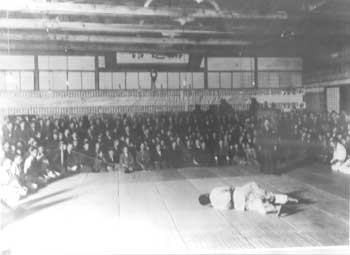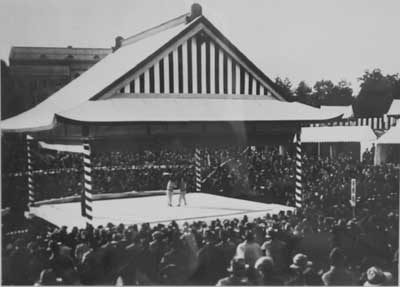by Neil Ohlenkamp
The rules of Judo competition have changed considerably over the past 120 years. At first, Kodokan Judo was seen as a form of jujutsu and matches were held in the older jujutsu style. An early participant in these matches, Sakujiro Yokoyama, is quoted as saying, “In those days contests were extremely rough and frequently cost the participants their lives. Thus, whenever I sallied forth to take part in any of those affairs, I invariably bade farewell to my parents, since I had no assurance that I should ever return alive.”Matches between different jujutsu schools were common, and the Kodokan participated in many such challenge matches. Kano wrote in his memoirs, “It seemed that the Kodokan had to take on the whole of Japan, and had to have a spirit of being ready for anything.” In 1886 a famous tournament hosted by the Tokyo Metropolitan Police Department was held between the relatively new Kodokan Judo and Totsuka-ha Yoshin-ryu jujutsu. This was a turning point for Judo. In 15 matches that lasted as long as an hour Kodokan Judo proved its dominance and secured its future. In Furyu: The Budo Journal, Wayne Muramoto writes, “The duels were probably closer to the original intent of the word shiai, which now means ‘match’ or tournament, but once referred to shi-ni-ai; to symbolically meet death itself. There were no yuko or koka (half or quarter points). You scored with a full ippon point; throws, chokes, holds or arm locks that would, in an actual situation, completely overwhelm your opponent. And the time limit was up to the judge. You usually went until someone dropped from sheer exhaustion or the judge ended it, awarding the match to the clear victor. Truly, it was shi-ni-ai.”
The first annual Judo competition began a few years earlier, in 1884, called Red and White Contests. The Red and White tournament is still held every year at the Kodokan, and it is now the longest running competitive sporting event in the world. Jigoro Kano had studied wrestling rules and had practical experience from jujutsu matches so he developed a set of rules to guide the contest. This photo shows a draft of the rules for the first Kodokan Red and White Contest. Also see the Original Rules of Judo and Contest at the Dojo.According to Contest Judo, by Roy Inman (1987), the Dai Nippon Butokukai, under the direction of Jigoro Kano, banned locks of the fingers, toes, wrists and ankles in jujutsu/judo contests in 1899. In 1916, ashi garami (knee entanglement, twisting knee lock), and dojime (trunk/kidney squeeze, performed from a body scissors) were banned by the Kodokan. Apparently, there were a number of serious injuries which resulted from the use of these techniques. Joint lock attacks in Judo contests were limited to the elbow only in 1925. Over the years other rules have been created to insure the safety of contestants. Until the 1970’s, the rules awarded ippon for lifting an opponent who is lying on his back to a height of your shoulders. This rule was later dropped to avoid the possibility of dropping a contestant from such a height. Another safety rule adopted was the banning of kani basami (flying scissors) after Yasuhiro Yamashita received a broken ankle from the technique endangering his entry in the 1984 Los Angeles Olympic Games (where he won the gold medal). While many of the modern rules were adopted for safety reasons, other changes were adopted to maintain fairness in matches, to encourage action, make Judo more spectator-friendly, and for other reasons. For example, Judo matches originally had no time limit, then in the 1950’s and 1960’s the rules called for a maximum of 20 minutes, and in the 1970’s the World Championship finals still lasted up to 15 minutes. However, as Judo became more and more popular match times had to be reduced to the current 5 minute limit. In 1974 the smaller scores of yuko and koka were added, and a penalty (shido) for passivity was introduced for the first time to prevent stalling. In 2009 the koka score was eliminated, and the first shido became a warning which did not count as a score for the opponent. Studies showed that very few contestants escaped from a pin (osaekomi) in the final few seconds, so in 2000 the rules changed to award a win for a 25 second hold, rather than the previous 30 seconds which had been required. Modern times have seen numerous other changes made in penalties regarding gripping and non-combativity in an effort to encourage exciting action.
The All-Japan Judo Federation recognized “The Contest Rules of Kodokan Judo” published by the Kodokan, and the International Judo Federation (IJF) also adopted these rules at its creation in 1951. Establishment of the IJF and standard international competition rules were required as Judo prepared for the first World Championships in 1956 and entry into the Olympic Games in 1964. This has led to increasing international influence on the rules.A major change in Judo was the introduction of weight categories for the Olympic Games in 1964. Until then world championships were open to all weights in one category, but starting with the Tokyo Olympics 3 weight categories (-68 kg, -80 kg, +80 kg) were introduced in addition to the open category. The categories were expanded to 6 (including an open weight category) by the next Olympics, and expanded again to 8 categories for the 1980 Olympics. In 1992 the open weight category was dropped from the Olympics so there are currently 7 weight categories for both men and women in the Olympics. The world championships continue to include the open weight category in addition to the 7 Olympic weight categories. For more information about the early development of weight classes see this letter. Although formal rule changes must be adopted by the IJF Congress, changes are frequently made by the IJF Refereeing Commission in between meetings of the full Congress. For example, the 2003 rules were amended by the IJF Refereeing Commission to include a penalty for Kawazu Gake, creation of a Golden Score overtime, the simplification to only two types of penalties (Shido and Hansoku Make) instead of four (Shido, Chui, Keikoku, Hansoku Make), and new bowing procedures which were implemented in advance of the publication of the new rules. Prompted by the intention of the All Japan Judo Federation to stage the 1st World Judo Championships in Tokyo in 1956 the Contest Rules of the Kodokan Judo were formulated and written in about 1948, with translation being officially made into English. If you would like to know more about how the rules of Judo competition have evolved you might be interested in seeing these official International Judo Federation (IJF) rulebooks:
|




